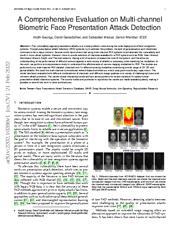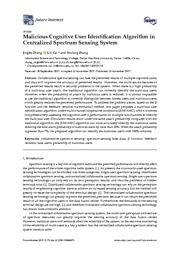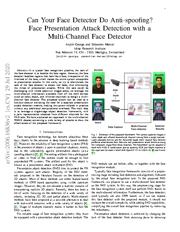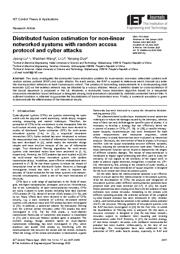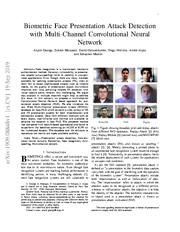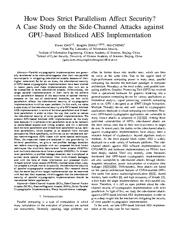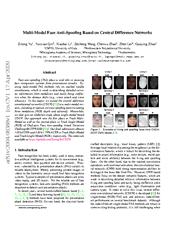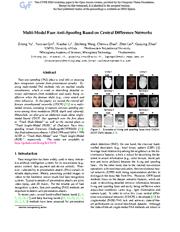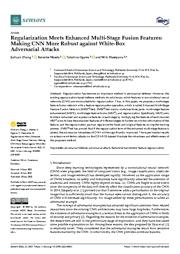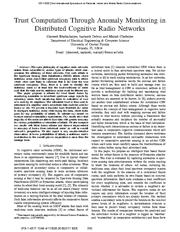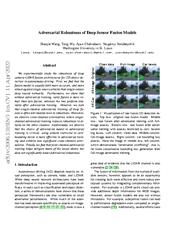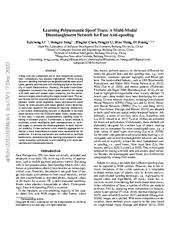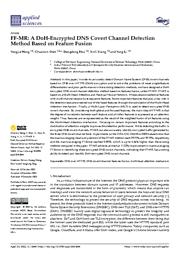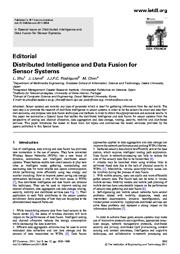A copy of this work was available on the public web and has been preserved in the Wayback Machine. The capture dates from 2022; you can also visit the original URL.
The file type is application/pdf.
Filters
A Comprehensive Evaluation on Multi-channel Biometric Face Presentation Attack Detection
[article]
2022
arXiv
pre-print
The studies are performed on a multi-channel PAD dataset, collected with 14 different sensing modalities considering a wide range of 2D, 3D, and partial attacks. ...
We used the multi-channel convolutional network-based architecture, which uses pixel-wise binary supervision. ...
In this work, the objective is to analyze the performance of multi-channel presentation attack detection systems against a wide variety of attacks. ...
arXiv:2202.10286v1
fatcat:z2wmb3ik3retbhcekfxww6pv4q
Malicious Cognitive User Identification Algorithm in Centralized Spectrum Sensing System
2017
Future Internet
To address the problem above, based on the β function and the feedback iteration mathematical method, this paper proposes a malicious user identification algorithm under multi-channel cooperative conditions ...
However, the multi-source features of the perceived results result in security problems in the system. ...
Figure 2 shows for the specific channel 1 N B − , the data fusion center analyzes each cognitive
Figure 3 . 3 Multi-channel collaborative spectrum sensing system model based on β-reputation system. ...
doi:10.3390/fi9040079
fatcat:hq4o3tdyibezbidsdbbv26za7y
Can Your Face Detector Do Anti-spoofing? Face Presentation Attack Detection with a Multi-Channel Face Detector
[article]
2020
arXiv
pre-print
design a multi-channel face detector. ...
We have evaluated our approach in the multi-channel WMCA dataset containing a wide variety of attacks to show the effectiveness of the proposed framework. ...
Score level fusion achieved better performance as compared to feature fusion in detecting attacks prepared using different kinds of printers. ...
arXiv:2006.16836v2
fatcat:zzy4iesqhfasxlqgtejhmfuoey
Distributed fusion estimation for nonlinear networked systems with random access protocol and cyber attacks
2020
IET Control Theory & Applications
This study investigates the distributed fusion estimation problem for multi-sensor non-linear networked systems with random access protocol (RAP) and cyber attacks. ...
The process of transmitting measurements to a corresponding local estimator (LE) via the wireless network may be attacked by a vicious attacker. ...
Inspired by the multi-channel transmission framework [13, 14] and RAP [25, 26] , a multi-sensor multi-channel transmission framework is designed to decrease the damage of cyber attacks. ...
doi:10.1049/iet-cta.2020.0040
fatcat:sov4gsc3mrfdrp3ybqlxg2iuxm
Biometric Face Presentation Attack Detection with Multi-Channel Convolutional Neural Network
2019
IEEE Transactions on Information Forensics and Security
In this context, we propose a multi-channel Convolutional Neural Network based approach for presentation attack detection (PAD). ...
We also introduce the new Wide Multi-Channel presentation Attack (WMCA) database for face PAD which contains a wide variety of 2D and 3D presentation attacks for both impersonation and obfuscation attacks ...
THE WIDE MULTI-CHANNEL PRESENTATION ATTACK DATABASE The Wide Multi-Channel presentation Attack (WMCA) database consists of short video recordings for both bonafide and presentation attacks from 72 different ...
doi:10.1109/tifs.2019.2916652
fatcat:s7ykireul5harmgrspvz76nsgi
How Does Strict Parallelism Affect Security? A Case Study on the Side-Channel Attacks against GPU-based Bitsliced AES Implementation
[article]
2018
IACR Cryptology ePrint Archive
In bit-level parallelism, we give a non-profiled leakage detection test before mounting attacks with our proposed bit-level fusion techniques like multi-bits feature-level fusion attacks (MBFFA) and multi-bits ...
decision-level fusion attacks (MBDFA). ...
Just on the contrary, appropriate multi-bits fusion techniques may improve the above attacks. We propose a multi-bits feature-level fusion attack. ...
dblp:journals/iacr/GaoZC18
fatcat:hnfnafiu55cz3gubjiovuchswe
Multi-Modal Face Anti-Spoofing Based on Central Difference Networks
[article]
2020
arXiv
pre-print
., cross attack and cross ethnicity). ...
Our approach won the first place in "Track Multi-Modal" as well as the second place in "Track Single-Modal (RGB)" of ChaLearn Face Anti-spoofing Attack Detection Challenge@CVPR2020 . ...
Multi-Modal Fusion Strategies. As shown in Table 4 , our proposed multi-modal CDCN (i.e., feature-level fusion with three modalities) achieves the lowest ACER (0.42%) in protocol 4@1. ...
arXiv:2004.08388v1
fatcat:5ej47ypxefd5rc4darlvcyx64i
Multi-Modal Face Anti-Spoofing Based on Central Difference Networks
2020
2020 IEEE/CVF Conference on Computer Vision and Pattern Recognition Workshops (CVPRW)
Our approach won the first place in "Track Multi-Modal" as well as the second place in "Track Single-Modal (RGB)" of ChaLearn Face Antispoofing Attack Detection Challenge@CVPR2020 [20] . ...
., cross attack and cross ethnicity). ...
Multi-Modal Fusion Strategies. As shown in Table 4 , our proposed multi-modal CDCN (i.e., feature-level fusion with three modalities) achieves the lowest ACER (0.42%) in protocol 4@1. ...
doi:10.1109/cvprw50498.2020.00333
dblp:conf/cvpr/YuQLWZLZ20
fatcat:kkisuc7aoncg7hs2majw4uqaoy
Regularization Meets Enhanced Multi-Stage Fusion Features: Making CNN More Robust against White-Box Adversarial Attacks
2022
Sensors
Thus, in this paper, we propose a multi-stage feature fusion network with a feature regularization operation, which is called Enhanced Multi-Stage Feature Fusion Network (EMSF2Net). ...
EMSF2Net mainly combines three parts: multi-stage feature enhancement (MSFE), multi-stage feature fusion (MSF2), and regularization. ...
The enhanced multi-stage fusion feature in EMSF 2 Net can represent and keep the global information of each channel well. ...
doi:10.3390/s22145431
pmid:35891112
pmcid:PMC9324889
fatcat:5qnplp47zrfvfjf6pnff7p5iuy
Trust computation through anomaly monitoring in distributed cognitive radio networks
2011
2011 IEEE 22nd International Symposium on Personal, Indoor and Mobile Radio Communications
We also compare our results with blind fusion scheme and observe improvement in accuracy of fusion from individual nodes' as well as overall network's perspective. ...
The calculated trust is then used to determine if a neighbor node's advertised data could be used for fusion or not. ...
Due to typical channel impairments like shadowing and multi-path fading, localized spectrum sensing by individual nodes is often erroneous. ...
doi:10.1109/pimrc.2011.6140031
dblp:conf/pimrc/BhattacharjeeDC11
fatcat:3wmcmy63hje2tfhiggwvfccsui
Flexible-Modal Face Anti-Spoofing: A Benchmark
[article]
2023
arXiv
pre-print
We also investigate prevalent deep models and feature fusion strategies for flexible-modal FAS. We hope this new benchmark will facilitate the future research of the multi-modal FAS. ...
Face anti-spoofing (FAS) plays a vital role in securing face recognition systems from presentation attacks. ...
To better leverage contextual modality information and eliminate redundancy, spatial [20] and channel [20, 32] attention is applied in multi-modal fusion. ...
arXiv:2202.08192v3
fatcat:4h424h3pnrdafhh4hjku6fy33i
Adversarial Robustness of Deep Sensor Fusion Models
[article]
2022
arXiv
pre-print
Moreover, we observe cross-channel externalities, where single-channel adversarial training reduces robustness to attacks on the other channel. ...
First, we find that the fusion model is usually both more accurate, and more robust against single-source attacks than single-sensor deep neural networks. ...
Additionally, several efforts have shown that fusion models can exhibit single-channel and multi-channel vulnerabilities [34, 21, 16] . ...
arXiv:2006.13192v3
fatcat:zt7mdv2jdndfxkas7xremtcxsi
Learning Polysemantic Spoof Trace: A Multi-Modal Disentanglement Network for Face Anti-spoofing
[article]
2022
arXiv
pre-print
This paper focuses on this issue and presents a multi-modal disentanglement model which targetedly learns polysemantic spoof traces for more accurate and robust generic attack detection. ...
Furthermore, a fusion module is exploited, which recalibrates both representations at multiple stages to promote the disentanglement in each individual modality. ...
(Parkin and Grinchuk 2019) further introduces a multi-level fusion branch for improved results. (Chen et al. 2020a) presents MM-DFN to model multi-modal dynamic features. ...
arXiv:2212.03943v1
fatcat:ojckuz7vfnaehcr5ysy6mroloa
FF-MR: A DoH-Encrypted DNS Covert Channel Detection Method Based on Feature Fusion
2022
Applied Sciences
Thus, features are re-represented as the result of the weighted fusion of all features using the Multi-Head Attention mechanism. ...
Finally, a Multi-Layer Perceptron (MLP) is used to detect encrypted DNS covert channels. ...
An attacker can thus hide and encrypt the DNS covert channel via DoH to conduct malicious cyber attacks. ...
doi:10.3390/app122412644
fatcat:uj5kb5fumfbhvggl75pxiwm4hi
Editorial: Distributed intelligence and data fusion for sensor systems
2011
IET Communications
In this paper we summarise a Special Issue that tackles the distributed intelligence and data fusion for sensor systems from the perspective of coding and channel allocation, data aggregation and data ...
The next step is to promote the research of distribute intelligence in sensor systems in order to let the sensors be smart and take their own decisions, and propose new data fusion techniques and methods ...
While transmitting sensory data from local sensors to the fusion center [2] , the status of wireless channels will have impact on the performance of data fusion. ...
doi:10.1049/iet-com.2011.0534
fatcat:gfwzyd6qcrgv7khzzdp6lkdpmy
« Previous
Showing results 1 — 15 out of 22,081 results

